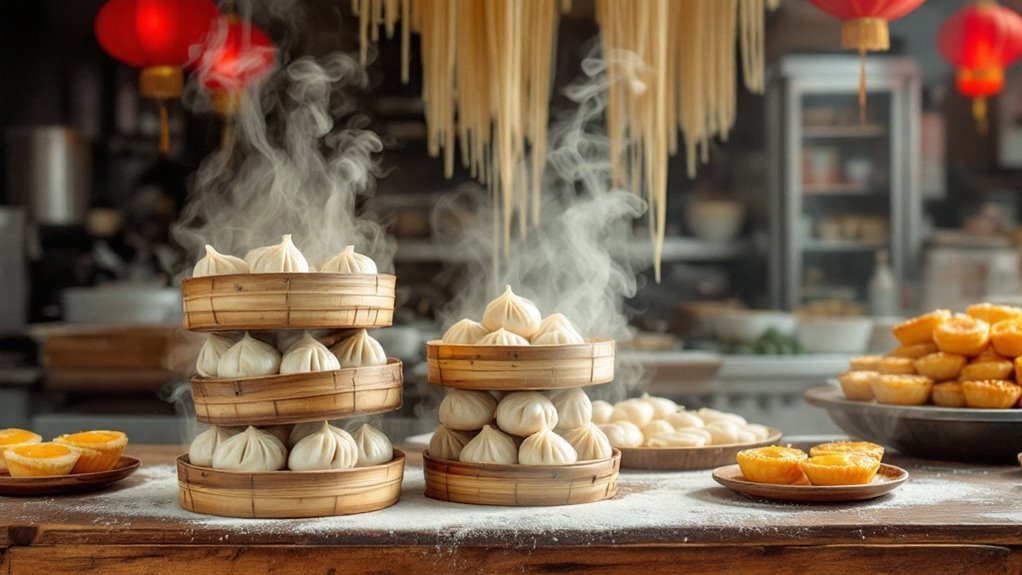NYC’s Chinatown offers essential food destinations for authentic Chinese cuisine. Joe’s Shanghai serves legendary soup dumplings, while Nom Wah Tea Parlor delivers classic dim sum since 1920. Hand-pulled noodles await at Tasty Hand-Pulled Noodles, and Mei Li Wah Bakery crafts celebrated pork buns. Local gems include Wah Fung No. 1’s char siu and Great NY Noodletown’s late-night fare. The neighborhood’s hidden culinary treasures emerge beyond the main thoroughfares.
Key Takeaways
- Joe’s Shanghai serves legendary soup dumplings and is considered a must-visit destination for authentic Chinese dumplings.
- Tasty Hand-Pulled Noodles offers authentic Lanzhou-style noodle soups with fresh, handmade noodles.
- Mei Li Wah Bakery specializes in traditional Chinese baked goods, particularly their famous pork buns and moon cakes.
- Visit restaurants during early morning hours (7-9 AM) for the best dim sum experience, especially at Nom Wah Tea Parlor.
- Look for restaurants with Chinese characters on menus and seasonal specials posted in red paper for authentic dining experiences.
Must-Visit Restaurants and Food Stalls in NYC’s Chinatown
While New York City’s Chinatown offers countless dining options, several establishments stand out as essential culinary destinations.
Joe’s Shanghai draws crowds for its legendary soup dumplings, while Nom Wah Tea Parlor, the neighborhood’s oldest dim sum restaurant, serves classic Cantonese fare since 1920.
Great NY Noodletown remains a late-night favorite for its roasted meats and pan-fried noodles.
For street food enthusiasts, Tasty Hand-Pulled Noodles offers authentic lanzhou-style noodle soups, and Wah Fung No. 1 Fast Food serves generous portions of char siu over rice.
Jing Fong provides a traditional dim sum cart experience in a grand setting, while Deluxe Green Bo specializes in Shanghai-style dishes.
The compact Mei Li Wah Bakery attracts locals and tourists alike for its renowned pork buns and moon cakes.
Local Tips for Finding the Best Authentic Chinese Food
To discover authentic Chinese cuisine in Chinatown, experienced local diners recommend looking for restaurants with primarily Chinese customers and menus featuring Chinese characters alongside English translations.
Locals suggest exploring the side streets rather than main thoroughfares like Canal Street, where many establishments cater to tourists. The most authentic spots often have simple decor and modest storefronts.
Early morning dim sum between 7-9 AM typically draws local Chinese families and seniors, indicating high-quality offerings.
Another reliable indicator is seasonal specials written on red paper in Chinese characters, posted on restaurant windows. These feature fresh, seasonal ingredients and traditional preparations.
Additionally, restaurants displaying tanks of live seafood and those that close earlier in the evening, around 8-9 PM, often serve more traditional fare.
FAQ
What Is the Best Time of Day to Visit Chinatown’s Food Spots?
The best time to visit Chinatown’s food spots is mid-morning to early afternoon, between 10 AM and 2 PM.
During these hours, restaurants and food stalls are fully operational, ingredients are fresh, and crowds are manageable.
Many establishments prepare their specialties in the morning, ensuring peak freshness.
Weekdays tend to be less crowded than weekends, offering a more relaxed dining experience.
Is It Better to Book a Guided Food Tour or Explore Independently?
Both guided food tours and independent exploration have distinct advantages.
Guided tours offer expert knowledge, cultural insights, and curated experiences without the need for research or navigation.
Independent exploration allows for flexible scheduling, personalized pacing, and the freedom to discover hidden gems while potentially saving money.
The choice ultimately depends on individual preferences, time constraints, and comfort level with self-guided culinary adventures.
Are Most Restaurants and Food Stalls in Chinatown Cash-Only Businesses?
While many establishments in Chinatown still operate on a cash-only basis, this practice has notably decreased in recent years.
Approximately 40% of vendors now accept credit cards and digital payments, though smaller food stalls and traditional dim sum spots often remain cash-only.
Visitors should carry cash as a precaution, but shouldn’t assume it’s the only payment option.
ATMs are readily available throughout the neighborhood.
Which Subway Stations Provide the Easiest Access to Chinatown’s Food Destinations?
Several subway stations provide convenient access to Manhattan’s Chinatown.
The Canal Street station serves multiple lines (N/Q/R/W, 6, J/Z), making it the primary gateway to the neighborhood.
Grand Street station (B/D) offers direct access to the eastern part of Chinatown, while East Broadway station (F) serves the southeastern section.
These stations place visitors within walking distance of popular food destinations throughout the neighborhood.
How Crowded Does Chinatown Get During Major Chinese Festivals and Holidays?
During major Chinese festivals like Lunar New Year and Mid-Autumn Festival, Manhattan’s Chinatown becomes extremely crowded, with streets packed shoulder-to-shoulder.
The Lunar New Year parade draws hundreds of thousands of visitors, making navigation challenging. Weekend crowds are particularly intense between 11 AM and 4 PM.
Many local businesses extend their hours during festivals, and restaurants often have long wait times.






